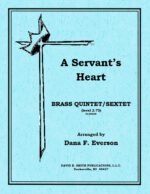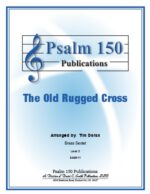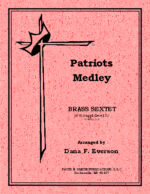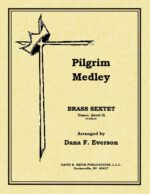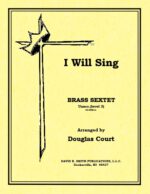| Instrument | |
|---|---|
| Occasion | |
| Theme | Thine Is The Glory |
| Writer | |
| Publisher | |
| Copyright | 1998 |
Thine Is The Glory
$17.50
3trp; 2tmb; tba; timp; voices; org: Thine Is The Glory
Related products
-
A Servant’s Heart
$10.00A brass quintet, optionally sextet, begins with a soulful trombone solo joined with the remainder of the lower brass instrument only to be taken over by the trumpets. The middle section uses a punctuated accompaniment for nice variety only to migrate to the flowing style of the beginning. It then ends in solemn repose.
-
The Old Rugged Cross
$10.00The introduction of this brass sextet (3 Trp., 3 Trom.) begins with strong choral movement and then settles into repose. The first presentation of the tune is in the trombones with a subtle counterline in the trumpets which then opens up to a stronger movement with the melody in the trumpet. The tune then reverts back to the trombones and then transitions to a move active support pattern in the trombones with a solo in the second trumpet. The final section gives way to a powerful presentation of the tune and immediately settles into a sensitive climate, much like the beginning. After a DC the piece ends with the strong motifs of the introduction giving a sense of finality. (Opt Horn for 1st Trom.)
-
Patriot’s Medley (Woodwind Supplement)
$7.00The score is set up various woodwinds to supplement the brass arrangement including: “God Of Our Fathers,” “Battle Hymn of the Republic,” and ending with “America.” It captures all the grandeur and majesty one would expect in an arrangement such as this.
-
Proclamation Medley
$12.00A brass sextet with opt. parts for flugelhorn and BHTC. The beginning presents a vigorous fanfare where it settles down into solemn rendition of “We’ve A Story To Tell To The Nations.” After a modulation the piece continues with “I Love To Tell The Story” with more open scoring passing the tune around amongst the parts. Another modulation, another tune- this time “Send The Light” in a march style giving purpose. Another modulation leading into “Since I Have Been Redeemed” in the upper parts, only to be followed with the theme in the lower voices. Then after a sequence of cascading entrance the piece concludes on a resounding sense of resolve.
-
Pilgrim Medley
$12.00A brass sextet with opt. parts for flugelhorn and BHTC. The beginning introduces stacked motives building to full chords. Following is a rendition of “When I Can Read My Title Clear” with melody broken down into fragments passed around to the various instruments. After key changes the quintet presents “I Am Bound For The Promised Land” in much the same fabric of the earlier section. After a brief transition in a new key we find “Just Over In The Glory Land” in a more flowing style than the earlier tunes. The Coda section becomes my rhythmically active where it ends on a solid chord .
-
I Will Sing
$11.00A vigorous piece that begins with extraneous thematic material that goes through various transformations that eventually breaks open to the theme of the title. An exciting brass ensemble that’s certain to please an audience of various venues.
-


